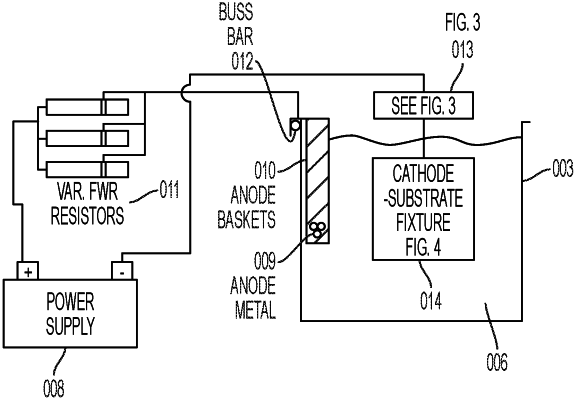| CPC C25D 3/562 (2013.01) [C03C 15/00 (2013.01); C03C 17/10 (2013.01); C25D 5/009 (2020.08); C25D 5/022 (2013.01); C25D 5/20 (2013.01); C25D 5/54 (2013.01); C25D 7/00 (2013.01); C25D 21/10 (2013.01); G01R 33/07 (2013.01); G01R 33/096 (2013.01); H01F 1/055 (2013.01); C03C 2217/261 (2013.01); C03C 2217/27 (2013.01); C03C 2218/115 (2013.01); C03C 2218/31 (2013.01); C03C 2218/34 (2013.01)] | 17 Claims |

|
1. A method to manufacture a magnetic sensor, comprising:
providing a bath of an electrolyte solution;
providing a substrate, wherein the substrate has a conductive layer deposited on the substrate;
submersing the substrate in the electrolyte solution;
submersing a plurality of ingots in the electrolyte solution, wherein the plurality of ingots comprise nickel ingots and iron ingots; and
depositing nickel (Ni) from the nickel ingots and iron from the iron ingots as well as nickel ions and iron ions already in the electrolyte solution on the substrate by applying a voltage between the plurality of ingots and the substrate to form an anisotropic magnetoresistive (AMR) sensor comprising a magnetic alloy layer that is magnetically permeable and magnetoresistive on the substrate;
wherein said depositing nickel and iron comprises depositing a magnetically coercive material on the substrate or on the magnetic alloy layer to provide a stack of alternating magnetically coercive layers, and magnetically permeable and magnetoresistive layers on the substrate;
wherein the conductive layer comprises a low conductivity material; and
wherein the electrolyte solution comprises sodium chloride as a Helmholtz layer intensifier at a Helmholtz layer of the substrate to deposit iron as 20 atomic percent to 21 atomic percent of the formed magnetically permeable alloy layer.
|